|
|
|
|
Yellow Line
Runs from Dempster Street, Skokie to Howard Street, Chicago via the north suburbs.

|
|||||||||||||||
|
Legend:
Click on a station name to see that station's profile (where available) |
|
|
|
|
Yellow Line
Runs from Dempster Street, Skokie to Howard Street, Chicago via the north suburbs.

|
|||||||||||||||
|
Legend:
Click on a station name to see that station's profile (where available) |
Service Notes:
Service Notes:
The Yellow Line (by that name) dates back to February 1993 when the CTA changed the route naming convention from individual, historic names to color coded nomenclature systemwide. The actual operation as we know it today, however, dates back to the creation of the line in April 1964.
The Yellow Line -- also known as the "Skokie Swift" -- is an unusual CTA operation in several ways. For one, the nearly five-mile line was, for nearly 50 years, the only nonstop shuttle service on the system, in many ways more closely resembling a light rail operation than rapid transit. Today it has regained an intermediate stop along the line, but still retains many attributes closer to modern light rail or an electric interurban of an earlier era than an urban rapid transit line. It was also the first line on the system to operate with one person transit operation (OPTO), with the motorman responsible for driving, working the door controls, and collecting fares (should no agent be on duty at Dempster), from the beginning of service (the Evanston Line began using OPTO a few years before). Finally, it is also interesting in that it is the only line that CTA ran, then abandoned, then resumed operation on. As such, it has a somewhat unusual history.
Niles Center Line

The open-cut portion of the Niles Center Line is under construction in this September 1924 view looking southwest from Asbury Avenue. As the surrounding environment suggests, most of south Evanston was largely undeveloped at this point. For a larger view, click here. (Photo from the Chicago Transit Authority Collection) |
In 1919, the Chicago, North Shore & Milwaukee Railroad began operating into downtown Chicago over the "L" , via the Evanston Line and North Side Main Line. The sharing of "L" trackage with the North Shore Line had many varied effects on the system over the years, but perhaps none was larger than the creation of the new line for the interurban from which the elevated reaped benefits as well. By the 1920s, the North Shore Line's route through the wealthy, built-up communities along the lake became less efficient, with increased population levels decreasing the speed of trains. So the company reached a decision to create the high-speed Skokie Valley bypass route.
The Skokie Valley route left the existing "L" system at Howard Street, branching to the west for approximately four miles before turning north. The bypass rejoined the North Shore Line's main line (thereafter largely known the the Shore Line Route) at South Upton Junction in Lake Bluff. The interurban's fast Chicago-Milwaukee trains saved up to twenty minutes by avoiding the congested Shore Line communities via the largely unoccupied Skokie Valley.The Chicago Rapid Transit Company (CRT), then the operator of the "L" system, was given the opportunity to provide local service between the North Shore Line's stations at Howard and Dempster Street Street in Niles Center (later renamed Skokie), both of which were shared with the interurban. It was believed that the extension of "L" service to the open lots of Niles Center would spur development. Construction of the new line was contracted to the Chicago North Shore & Northern Railroad Company. Work began on the five-mile segment for the CRT in April 1924 and progressed rapidly.

Although few people lived along the Niles Center line, a large crowd was on hand for the dedication ceremonies at Dempster Street on March 28, 1925. For a larger view, click here. (Photo from the Bruce G. Moffat Collection) |
Upon leaving the North Side main line at Howard, the Niles Center branch descended into an open cut for the trip due west. In west Evanston, the line rose back up, becoming elevated upon reaching Dodge Avenue. Crossing Dodge, the Chicago & North Western Mayfair division, North Shore Channel, and McCormick Boulevard at an elevated level, the line dropped to ground-level upon entering Niles Center. At East Prairie Avenue, the first street crossed at grade, the line changed from third rail to overhead operation. The line continued at grade to Skokie Boulevard, where it turned north and paralleled the boulevard to Dempster Street. Stations were constructed at Ridge, Asbury, Dodge, Crawford-East Prairie, Kostner, Oakton, Main, and Dempster. The CRT paid for all of their local stations except Oakton and Dempster, where the North Shore Line intended to also stop and share facilities. In the end, only Dempster was used by the interurban, skipping Oakton (even though it was the only station near the existing population in Niles Center).
The official opening was held on March 28, 1925, when three special trains carried CRT and North Shore Line officials to the ceremonies at Dempster Street. Approximately 2,000 people gathered to listen to the speeches, look at the new facilities, and watch an air show staged above the terminal. The Niles Center Line opened for regular service at the conclusion of the ceremony.The line typically operated single-car shuttle trains between Dempster and Howard, which was more than adequate to serve the largely-unpopulated land that surrounded most of the line at the time. During rush hours, the train lengths were doubled, but remained shuttles until 1929, when a rush hour through-service south of Howard was instituted. In the morning, eight Niles Center trains were coupled onto the back of southbound Jackson Park expresses for the trip downtown and nine northbound Howard expresses in the evening carried two cars to be split from the train at Howard for the trip to Dempster. This level of service, although much more convenient, was unwarranted by the sparse population along the line and dropped in 1930. Little changed on the line for the following decade and a half.
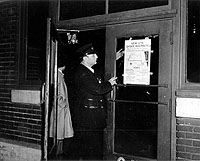
The end of the line for the Niles Center (by then, Skokie) branch: on March 26, 1948, CTA suspended service on the line. Conductor Arthur Gisiner is posting a map of the new #97 Skokie replacement bus route before locking the doors of the Oakton station for good, as he did at each station as the last train made its return trip to Howard. For a larger view, click here. (Photo from the CTA Collection) |
The CTA quickly changed all that. They studied each rapid transit line and monitored each station. Then, bit by bit, they closed the stations and lines that were most uneconomical and had the lowest ridership to concentrate on the stronger routes. By the time of its closure, the Skokie shuttle service was losing $200,000 a year. The Niles Center Line fell victim to this systematic pruning when on March 27, 1948, service between Howard and Dempster was replaced by the #97 Skokie bus line. This date was chosen in large part because it so happened that the North Shore Line's employees went on strike on this date -- one of several NSL strikes of the 1940s -- meaning that the Skokie Valley Route was not staffed, preventing the Niles Center branch from operating. Service had to be suspended on the branch due to the North Shore Line strike anyway, so the date the NSL employees walked out served as a good time to drop a service that was marginal at best.
The last Skokie shuttle train left Howard for Dempster at 11:45pm on Friday, March 26, 1948, with many of the car's passengers being railfans along for the last ride. The motorman on the last trip was Philip Finland and the conductor was Arthur Gisiner. On the trip back to Howard, Finland and Gisiner closed and locked each station and posted notices of the bus substitution on their front doors. The first westbound #97 Skokie bus left Howard at 12:01am, Saturday, March 27.
After the Niles Center branch service was discontinued, the local stations at Ridge, Asbury, Dodge, Crawford-East Prairie, Kostner, Oakton, and Main were closed, but the line itself and the Dempster station (though not the CRT's island terminal platform there) remained open and in use by the North Shore Line interurban. The CTA also continued to use the line between Howard and East Prairie Road for access to its Skokie Shops heavy maintenance facility, which was located half way down the line.
Skokie Line Swiftly Returns
By the early 1960s, most of Chicago's commuter railroads were under considerable financial strain and were on the path to either serious cutbacks or outright abandonment. The interurbans were no exception. In 1957, the Chicago Aurora & Elgin abandoned its services, and by the 1960s the North Shore Line was heading the same way. In 1955 it abandoned its Shore Line Route, instead concentrating on its high-speed Chicago-Milwaukee commuter service via the Skokie valley Route. But rising worker wages and operating costs, increasing automobile usage, and declining freight and passenger traffic (a problem caused, in part, by the closely-paralleling Chicago & North Western and Milwaukee Road lines to the east and west) were dooming the line. Ridership at its height in 1923 was 16 million passengers; in the final years it was down to 4 million. After repeated petition filings, the Interstate Commerce Commission granted the North Shore Line the right to begin abandonment process on May 18, 1962. The Chicago North Shore and Milwaukee ceased operation in the early morning hours of January 21, 1963.
The loss of this Insull interurban would net a considerable gain for the CTA , however. The CTA decided to take the opportunity this abandonment represented to conduct a pilot project for a new type of urban transit service. The principle objective of the experiment was to see if an effective, economical, and passenger-friendly service could be established linking a typical postwar suburb to an urban center. The abandoned right-of-way of the North Shore Line's Skokie Valley Route made this experiment all the more possible. The section between Howard and East Prairie Road had remained in use by the CTA for access to its Skokie Shops heavy maintenance facility, which made the conversion all the more appropriate.
 One of the novel aspects of the Skokie Swift operation was the way it catered to the auto with the provision of a large park'n'ride lot to entice auto-oriented suburbanites to the system. This view looks southwest in the parking lot, with the temporary Dempster station and a Swift train in the background, in 1964. For a larger view, click here. (Photo from the Chicago Transit Authority Collection) |
The reestablished service was not merely the reinstatement of the old Niles Center Line, but the same route with a new twist and several changes. The most striking change was that the service, which was to be recoined the Skokie Swift, was a nonstop shuttle between Howard at the Chicago city limits and Dempster in Skokie, about a mile north of the business district. All of the intermediate stations were to remain closed and local service would continue to be provided by the #97 Skokie bus. A Park'n'Ride lot for 555 cars was also constructed at the Dempster terminal in Skokie, along with a Kiss'n'Ride area (novel for the time) where riders could be dropped off and picked up by auto. Space was also provided for interchange between the Skokie Swift and suburban bus companies. All of these aspects were provided based on the idea that suburbanites heading to the city might be drawn out of their autos if a service was provided that was fast, attractive, and efficient, plus that they could drive (or be driven) to. These features allowed the new service to cater to the auto market, which was fast taking hold in suburban America. The station's close proximity to the Edens Expressway additionally helped this objective.
The initial plan was to provide fifty roundtrips a day at 15- or 30-minute intervals between 0600 and 2200 hours, Monday-Friday, except on holidays, with no service on weekends. Four experimental high speed cars -- 1-50 series units #1-4 -- were assigned, although only two cars were thought to be needed in the peak period. Patronage on opening day, April 20, 1964, was 3,939 riders and by the end of 1967 had risen to 7,500, a far cry from the 1,500 riders the North Shore Line had been carrying when it ceased service. Clearly, a revision in the operating plan was needed: the CTA's four articulated high-capacity cars -- 5000-series cars 51-54 -- were added for additional capacity, additional trips were added, and Saturday service was offered from the start. The line used driver-only operation, OPTO (one personal train operation), from the start, the first "L" line to do so from the onset of service (the Evanston Line had already begun using OPTO in 1961). During the first years of the Skokie Swift, a maximum operating speed of 70mph was reached, although this dropped to a regular operating speed of 46mph over the five-mile, nonstop line, making it the fastest rapid transit operation in the world.
 Above: Some of the people who helped make the Skokie Swift happen -- from executives to planners to motormen -- pose with the inaugural train on dedication day, April 18, 1964, at Dempster terminal. For a larger view, click here. (Photo from the CTA Collection) Left: An "I RODE THE FIRST DAY - CTA'S SKOKIE SWIFT - APRIL 18, 1964" button, handed out to guests of the demonstration rides from Dempster to Howard. For a larger view, click here. (Button from the Jerry Appleman Collection) |
 The
new extension provided an overwhelming demonstration of the demand
for good rapid transit in the suburbs: in its first year of operation
the Skokie branch carried nearly five times the anticipated number of
passengers. Just a few months after beginning service, the one-agent
booth at Dempster
had to be replaced with a two-agent booth to handle the large crowds.
At the end of its two-year experimental period in 1966, it was
concluded that a median-density suburban area could be linked
effectively with the central business district of a central city by a
high-speed transit service, provided that a public investment was
made in the infrastructure and equipment. The Skokie Swift was
continued after the two year demonstration ended, with the operation
continuing uninterrupted, and the route was absorbed into the regular
CTA system. The project helped
set the pattern for many new-start systems and was in many ways the
prototype for light rail long before that term was coined.
The
new extension provided an overwhelming demonstration of the demand
for good rapid transit in the suburbs: in its first year of operation
the Skokie branch carried nearly five times the anticipated number of
passengers. Just a few months after beginning service, the one-agent
booth at Dempster
had to be replaced with a two-agent booth to handle the large crowds.
At the end of its two-year experimental period in 1966, it was
concluded that a median-density suburban area could be linked
effectively with the central business district of a central city by a
high-speed transit service, provided that a public investment was
made in the infrastructure and equipment. The Skokie Swift was
continued after the two year demonstration ended, with the operation
continuing uninterrupted, and the route was absorbed into the regular
CTA system. The project helped
set the pattern for many new-start systems and was in many ways the
prototype for light rail long before that term was coined.
Since the local stations between Howard to Dempster used by the "L" between 1925 and 1948 were not part of the equation for the Skokie Swift, those facilities were now superfluous under the revised operation. The stations in Skokie were all removed in the late spring and early summer of 1964, but the Evanston stations remained until the 1980s, adaptively reused and rented out by the CTA as businesses.
After the Skokie Swift ended as a demonstration project and became a regular CTA rapid transit line in 1966, the route remained largely the same for the next several decades. In the mid-1970s, the Skokie Swift again became a testbed for a short period, when the United States Department of Transportation's "State-of-the-Art Cars" (SOAC), a train of experimental rapid transit units that the US DOT sponsored to develop a standard transit car design, were tested on the Swift in January 1975, as well as in New York City, Boston, Philadelphia, and a few other cities. In 1985, the 5000-series articulated cars 51-54 were retired, replaced with five married-pair 61-65 series units, cars #61-65.
 Car 3447-48, one of the new 3200-series units that replaced the old PCCs, is turning into Oakton Curve on Yellow Line near Kenton Avenue on December 3, 2001. For a larger view, click here. (Photo by Mike Farrell) |
Lest the CTA's commitment to the Yellow Line seem to have been in question, the agency continued its reinvestment in the line. In October 1993, the old 5-50 and 61-65 series PCC cars were largely retired from regular service, with operations taken up by a set of the CTA's newest cars, the 3200-series units, specially equipped with pantographs to operate on the Swift. The "temporary" Dempster station built for the demonstration project in 1964 served for about thirty years, but was finally replaced with a new, more substantial, permanent brick station house designed by Dubin, Dubin and Moutoussamy, costing $3.4 million. Construction began in 1993, with the completed terminal coming into use at the end of May 1994.
In Fall 2002, the CTA temporary provided weekend service on the Yellow Line as part of their expanded holiday hours. For the first time in the history of the Skokie Swift, service was offered all weekend on the line, since although Saturday service was operated from 1964 to 1992, regular Sunday service has never been offered. The service was operated between Thanksgiving and Christmas as a pilot program for future holiday weekend service, or possibly even all-year weekend service someday. The Yellow Line operated from 0940 to 2300 hours on November 30 and December 1, 7, 8, 14, 15, 21 and 22.
End of the (Overhead) Line
In the early 2000s, the CTA made a decision that would alter the character of the Yellow Line forever: to convert the route from overhead catenary operation to third rail traction power. The CTA desired to convert the ground-level portion of the line to improve reliability and performance. The Skokie line was the only route in the CTA to still use overhead wire, making it an aberration in the 226-miles rail system and requiring unique equipment to operate and maintain it. The overhead wire required regular maintenance and inspection and occasionally broke during the winter due to freeze-thaw cycles. Conversion to third rail allowed trains from other routes to be used interchangeably on the Swift, making it easier to swap out a broken car or to add service. Purportedly, the change also makes it easier for the Yellow Line to be extended north to Old Orchard Shopping Center, a popular but still-conceptual project for the northern suburbs, according to CTA officials.
"Having third-rail power on the entire Yellow Line also creates future opportunities for service improvements, such as adding to the frequency of the service, or extending the line to Old Orchard or even beyond," CTA President Frank Kruesi said. (See below for more on the extension.)
Still, the overhead wires were a trademark of the Swift since its opening in 1964 and were one of the last remaining parts of the North Shore Line to be in active, revenue operation.
 On September 11, 2004, a four-car train of pantograph-equipped Yellow Line cars, trailed by car 3441, pass Crawford Avenue while performing a test of the new third rail traction power. The pantographs, once necessary to operate on the Yellow Line beyond Skokie Shops, are locked down and now superfluous. The test was successful and the third rail officially entered revenue service two days later. For a larger view, click here. (Photo by Graham Garfield) |
The Federal Transit Administration, Regional Transportation Authority and the Illinois Department of Transportation funded the $6.3 million project.
Beginning in late summer 2002, contractors made the necessary preparations for conversion of the line to third rail operation by running cable ducts and making other necessary changes for the cab signal and traction power systems. In January 2004, CTA completed the replacement of the warning systems at eight Yellow Line grade crossings in Skokie. The third rail sections themselves were delivered to Skokie Shops in Spring 2004 and the Power & Way Department began installation on June 12, 2004. The last section to be laid was at Searle Crossover during August. During August and September, several smaller items were worked on, such as fencing repair and the replacement of several "cattle guards" -- the saw-tooth-profile wooden wedges placed between the tracks at street crossings -- both of which are critical to assure passersby are kept out of the right-of-way.
The last day of revenue operation for the overhead catenary was Friday, September 10, 2004. On Saturday, September 11, the overhead was de-energized and disconnected from Skokie Substation. The third rail was energized and from 0800 to 1200 hours, test trains were operated to test the third rail and signals. A 4-car train of Yellow Line 3200-series cars was planned, but to give the new traction power system a real workout twice the number of cars were operated during the test. The eight 3200s -- all but two of the cars assigned to the line at the time -- sometimes ran as two 4-car trains and sometimes as one 8-car train. Tests were also run to adjust the timing on the grade crossing signals. With results from the test deemed satisfactory, the Yellow Line officially began revenue service with third rail traction power between Hamlin and Skokie station at 0400 hours on Monday, September 13, 2004.
Following the conversion, the overhead catenary and rail car roof-mounted pantographs were no longer necessary. The CTA did not remove them immediately, however. Although they were superfluous now, it was not essential that they be dismantled and some delay to make sure there were no bugs in the new traction power system would be prudent. By early November, however, the Authority was ready to begin removing these features.
 The Power & Way crew that dismantled the catenary used a high railer line truck to reach up and sever the wires. On Saturday, November 13, 2004, they are removing the contact wire at Oakton Street. For a larger view, click here. (Photo by J. Terrell Colson) |
The next phase of wire removal began over the weekend of December 4-5, 2004, at which time the Power & Way Department would begin removing the secondary messenger wire (which is above the contact wire) over the northbound track. The southbound secondary messenger was removed weekend of December 11-12. The primary messenger wire (which is the highest wire) will not be removed until a future date because it will be more difficult to dismantle as it goes over the top of the towers. The catenary towers themselves will stay in place for the foreseeable future, as they are difficult and costly to remove and carry ComEd cables as well as CTA communications and signal cables.
As a result of discontinuing the use of the overhead catenary, a reduced speed zone at Oakton Curve is able to be removed. Yellow Line runs will be 40 seconds shorter if and when the CTA receives permission from the Illinois Commerce Commission to increase speeds along the curve to 55mph from 35mph, according to the CTA . Approval was expected in October 2004.
Not long after the wire began coming down, the pantographs on top of the Skokie cars began to disappear. Although the CTA planned to keep the same ten cars assigned to the line as when overhead traction power was used, it was decided to remove the pantographs. The first cars to have their pans removed were 3445-3446. Cars 3457-58, a mismatched pair of one 2600-series car and one 3200-series car normally assigned to the Purple Line, were unofficially assigned to Skokie service until the C-level light overhauls of the Skokie 3200-series cars were complete. By mid-January 2005, the last Skokie cars had lost their pans.
In early 2007, another remnant of the North Shore Line was removed from the Yellow Line. Over the weekend of February 17-18, 2007, Dempster Tower was demolished. The interlocking tower, which stood approximately 300 feet south of the Skokie station platforms, once controlled the junction between the Skokie Valley main line tracks and the spur to the stub platform behind the old Dempster station where Chicago Rapid Transit Niles Center branch "L" trains terminated. The tower was last used in revenue service in March 1948, when the CTA suspended "L" service on the Niles Center branch and the stub platform was no longer used. The masonry tower, whose design complimented the historic Dempster station, stood dormant for the six decades thereafter.
Expanded Service
On February, 13, 2008, the Chicago Transit Board approved service enhancements for the Yellow Line that would be funded through grants.
The Yellow Line added weekend service to improve access to major employment centers in Skokie including Westfield Old Orchard and Lutheran General Hospital. The addition of weekend service brought regularly-scheduled Saturday service back to the Yellow Line for the first time since 1992, while regularly-scheduled Sunday service is being provided for the first time since the Skokie Swift began service in 1964.
Weekend Yellow Line service began Sunday, March 30, 2008. Trains operated on Saturdays and Sundays from 6:10 a.m. to 11:15 p.m. at 15-minute intervals. Funding for the additional service was from a Congestion Mitigation and Air Quality Program (CMAQ) grant.
The CTA Board established the weekend service as a 180-day experiment, to be evaluated to determine whether the additional service should ultimately be kept, adjusted, or discontinued. In autumn 2008, the experiment was renewed for another 180 days. On June 10, 2009, the Chicago Transit Board voted to make the weekend Yellow Line service permanent effective immediately. At the time of the vote, the addition of weekend service had a positive impact on ridership, with the Yellow Line averaging 1,866 and 1,336 daily rides on Saturdays and Sundays, respectively.
What the Future Holds...
In-Fill Stations
Continued interest in the Swift has manifested itself in the desire to reestablish at least one of the local stations, both in the Village of Skokie and in the City of Evanston. These projects would change the nature of the Yellow Line's fast, nonstop shuttle operation, though one additional stop might not make a substantial enough difference to substantially alter the service provided.
In Skokie, site one most commonly discussed has been Oakton, since it would serve Skokie's downtown and would likely have the most potential traffic. However, other locations such as Crawford-East Prairie or Kostner have also been discussed. While the case for choosing Oakton as the location for reestablishing a station would seem to be the most obviously strong, it was necessary to formally study the issue to assure that Oakton was the best location and that a station would generate sufficient traffic to justify the cost of constructing and operating it. Such a study was commissioned by the Village of Skokie and completed in Fall 2003, and indeed recommended establishing an "infill" station at Oakton.
In early 2005, the Village of Skokie received $417,000 in a federal grant earmarked for the station's design, which covered about 80 percent of design costs for the station. The village picked up the remainder, about $104,000. Then, in mid-2005, village staff submitted a grant proposal to the federal Congestion Mitigation and Air Quality grant program, which provided funds for projects that contribute to traffic congestion relief and cleaner air quality. In late November 2005, the Skokie secured a $1 million federal grant for the village's downtown Skokie Swift project with the help of U.S. Rep. Jan Schakowsky (D-9th). Then, in early December 2005, Skokie learned they would receive an additional $9.2 million in federal grant funds to construct the station. The entire project was originally estimated to cost about $15 million in 2005, including any land acquisition needed, , but the total cost rose to more than $20 million by 2010. By that time, the $20 million cost was split between a $14.1 million federal grant and $6 million from the village's tax increment finance fund. Construction of the Oakton-Skokie station began in late 2010, with the station opening on April 30, 2012. For more information about the station's planning, design, and construction, see the Oakton-Skokie station profile.
Meanwhile, in November 2003, City of Evanston leaders announced renewed interest in creating an intermediate stop of their own. A study to be commissioned by Evanston will determine whether there's demand there and elsewhere. In 2007, the City joined the Village of Skokie and the Regional Transportation Authority in a project, the Skokie Swift North Shore Corridor Travel Market Analysis, to examine how to expand the Yellow Line. In addition to identifying major travel patterns and markets that could support a line extension, the study also evaluated three potential new station locations in south Evanston -- at Dodge, Asbury, and Ridge. The study found that depending on location, a new station could expand the total number of work trips served by the Yellow Line by 25 to 45 percent and attract up to 1,000 riders per day, potentially more if the Yellow Line offered direct service to downtown Chicago. However, the study identified no single station location as clearly superior to the others based on the criteria. The study recommended that the relative costs of constructing a station at one or more of the locations be evaluated in an engineering feasibility study to provide clearer direction on a preferred station location(s).
As recommended by the 2007 study, the City of Evanston initiated the Yellow Line Station Engineering Feasibility Study Project in 2011 to study and determine which location was best suited for a new station. In January 2012, the study identified Asbury as the best location for a new Yellow Line station in south Evanston. When comparing Dodge and Asbury, officials found that the area around Dodge is less densely populated than Asbury, reducing the potential for walk-in traffic or traffic generators to draw destination ridership. Another key factor against the Dodge station location, officials said, is that the existing 85-year-old bridge over Dodge Avenue would need to be reconstructed to support a new station, adding another $10 million to the capital costs. Following approval of the study and recommended location by the City Council in April 2012, the Illinois Department of Transportation began engineering design for the site and conduct a detailed analysis of construction costs and environmental impact, as well as get more input from the community. Funding would also still need to be identified to construct and operate the station.
There has also been an interest on the part of the Village of Skokie for extensions of the service north to Lake-Cook Road in Highland Park, IL (a location also previously served by the North Shore Line) and south from downtown Skokie to Montrose Avenue and a connection to the O'Hare branch. These projects are in the 2020 Transportation Plan, but await capital funding. The CTA has expressed interest in the northward extension, though only as far north as Old Orchard shopping center. The CTA has not set a concrete timetable for this project, though one might expect that a 20 year window would not be unrealistic. CTA President Frank Kruesi helped ensure that the Swift's north extension to Skokie's Old Orchard was placed on an eligibility list for federal funding.
Possibly affecting the feasibility of a northward extension, in late July 2004 the Union Pacific Railroad's Skokie Industrial Lead -- the Skokie Valley Route tracks north of Dempster original laid by the North Shore Line, but later taken over the by Chicago & North Western and then by UP -- were officially abandoned by the UP. The line fell into disuse in the early '90s, and was mothballed in 2002. Although the Surface Transportation Board mandated that the tracks be left in place for future transit use, scrappers pulled up most of the rail in summer 2004. This was apparently done without the knowledge of Skokie village officials, although they noted that even if the Swift was extended north the existing tracks would have been replaced anyhow due to their deteriorated condition. Still, the Village wants to preserve the right-of-way for future transit use and perhaps build a bike path there in the mean time to keep it open and in use.
Preliminary engineering studies were performed on the feasibility of the extension by the Chicago-based Parsons Brinkerhoff Quade and Douglas firm. The extension, which is backed by Skokie Mayor George Van Dusen, is projected to cost more than $300 million. In November 2003, the Skokie Village Board approved a recommendation from its plan commissioners to include the Swift extension in Skokie's comprehensive plan. Mayor Van Dusen and CTA President Kruesi both say a number of critical questions must be answered. One is whether the Old Orchard terminal will be at ground level or in a subway. Another is how long platforms will be.
Van Dusen's enthusiasm is not shared by officials farther north, particularly in Northfield and Northbrook, who have asked long-term planners to shelve extension of the Swift to the county line, and Northbrook Court.
In July 2005, funding for five CTA New Starts projects was authorized as part of the reauthorization of the federal transportation bill, known as SAFETEA-LU (Safe, Accountable, Flexible, Efficient Transportation Equity Act - A Legacy for Users): the Circle Line, the Ogden Corridor project, an extension of the Red Line to 130th Street, an extension of the Orange Line to Ford City, and an extension of the Yellow Line to Old Orchard.
SAFETEA-LU will provide a total of $286.4 billion nationwide through 2009. Of that amount, $52.6 billion is earmarked for capital transit projects. For the period 2004-2009, Illinois is authorized to receive $2.6 billion in transit formula funds and CTA will receive approximately $1.3 billion of that amount.
At their November 9, 2005 monthly meeting, the Chicago Transit Board approved changes to the proposed 2006-2010 five-year capital plan in order to begin alternatives analysis studies for extending the Red Line, Orange Line, and Yellow Line. (Alternatives analyses were already underway at that time for the Circle Line and Ogden projects.) The alternatives analysis study is the first planning step in the Federal Transit Administration's New Start process for the purpose of pursuing federal funding. The studies will examine all of the transit options available and a locally preferred alternative will be determined.
The FTA New Starts program requires conceptual transit project proposals to proceed through a formal process of planning, design and construction. The FTA process consists of five formal steps: Alternatives Analysis, Environmental Impact Statement, Preliminary Engineering, Final Design and Construction. The alternatives analysis studies are designed to identify the preferred form of transit for the areas, routes, station locations, preliminary ridership estimates, constructability reviews and risk assessments, operating and capital cost estimates, and implementation schedules. The Board voted to set aside $6 million in capital funds for the three studies.
"In keeping with the RTA's directive to develop strategic plans for future transit needs, and the state's pledge to leave no federal funding on the table, the CTA intends to move ahead to further develop plans to extend our system and provide additional transit options for the region," said Chicago Transit Board Chairman Carole Brown. "These transit projects will help CTA continue to meet the dynamic needs of a growing and interdependent region."
In order to secure the federal funding available under SAFETEA-LU, CTA must secure at least 20 percent in matching funds from non-federal sources. Securing CTA's formula funds for 2006 through 2009 -- not including New Start grants -- will require more than $200 million in matching funds. CTA is working with the Regional Transportation Authority (RTA) and the Illinois Legislature to enact a replacement of Illinois FIRST and ensure that all federal transit funds available to the Chicagoland region will be appropriated.
In the FY 2006 Federal Transportation Appropriations bill, which became law on November 30, 2005, $1 million was provided for performing an Alternative Analysis for the Yellow Line extension.
On September 13, 2006, the Chicago Transit Board approved a $3.5 million contract to Parsons Brinckerhoff Quade & Douglas Inc. to perform Alternatives Analysis studies for the proposed rail line extensions on the Red, Orange and Yellow lines. CTA is considering extending the Red Line to 130th Street, the Orange Line to the Ford City Mall and the Yellow Line to Westfield Shoppingtown Old Orchard shopping center. FTA Formula Funds provided the funding for the $3.5 million contract.
Extending the Yellow Line would provide service to major destinations such as Old Orchard Mall, Cook County Courthouse, and adjacent office and retail developments currently just beyond the reach of the existing terminal. Expanding service would strengthen the reverse-commute flow along both the Yellow and Red lines, and make better use of CTA's existing service capacity.
On August 12, 2009, the Chicago Transit Board voted to adopt the locally preferred alternatives (LPAs) proposed for the Red, Orange and Yellow Line extension projects. Following the steps required by the Federal Transit Administration (FTA) in order to apply for funding, the CTA studied all of the potential options available for each of the projects, and narrowed it down to one viable option for each proposed extension.
For the Yellow Line extension, the CTA recommended a single-track elevated rail extension from the current Skokie station to Old Orchard Road. This extension would include 1.6 new miles of rapid transit, one additional station at Old Orchard Road, new railcars, a new bus terminal facility and a parking structure that includes space for commuters and full replacement of existing spaces at Niles North High School impacted by the transit facility.
The alignment would run from the current Skokie station following the Union Pacific Railroad right-of-way over Dempster Street, Gross Point Road, Church Street and Golf Road and east along the Edens Expressway right-of-way, then will end at a double-track station between the Edens Expressway and Niles North High School south of Old Orchard Road.
Despite declaration of the above-described mode and alignment being the "locally-preferred alternative", resulting from a long series of public meetings, surveys, formal comment, and coordination with local officials, significant opposition to this plan remained amongst local residents. Skokie residents, at a September 23, 2009 public scoping meeting, so vigorously opposed the original suggestion that even Skokie Mayor George Van Dusen -- a long-time champion of the project -- turned against it by evening's end.
CTA officials in early April 2010 said the agency neither supports nor opposes putting the proposed terminal adjacent to Niles North High School in the school's parking lot, one of the significant points of contention with the LPA plan. The terminal's placement will largely be determined by the Environmental Impact Statement, required by federal law to access federal transit funds to build the 1.6-mile extension, according to the CTA.
But along with opposition to the parking lot plan, some residents, under an organization calling itself Skokie Reasonable Transit, oppose any use of the former North Shore Line right-of-way for rail or bus rapid transit, saying such use would disrupt their neighborhoods and quality of life.
Although the original timeline for the Yellow Line extension had preliminary engineering and a draft Environmental Impact Statement taking place in 2010-11, with the final EIS and engineering, construction occurring in 2011-13, and service beginning as soon as 2016, the reality is far less clear, especially as long as significant community opposition to the identified locally preferred alternative remains and competition remains fierce for limited federal funds for transit capital improvements.
CTA President Forrest Claypool told Newsradio 780 on July 8, 2011, that the proposed Orange and Yellow Line extensions will not get past the planning phase without a turnaround in the agency's finances. While Mayor Rahm Emanuel and Claypool declared upon taking office Red Line North Side reconstruction and South Side extension to be priorities, they said the agency has too many other capital needs that are far too urgent.
Claypool said the Orange Line and Yellow Line extensions are not dead. Rather, he said, planning will continue so they can "be taken off the shelf" if finances improve.
 |
SwiftPamphlets.gif
(136k) |
 |
cta1-50s@Skokie.jpg
(98k) |
 |
cta4b.jpg
(50k) |
 |
cta4269.jpg
(50k) |
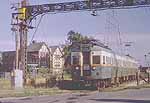 |
cta51c.jpg
(149k) |
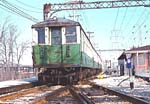 |
cta4000s10.jpg
(144k) |
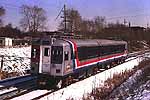 |
cta75.jpg
(231k) |
 |
SOAC
05.jpg (113k) |
 |
cta53i.jpg
(131k)\ |
 |
cta41-28.jpg
(122k) |
 |
turnback.jpg
(128k) |
 |
ROW@SearlePkwy-cta3449.jpg
(126k) |
 |
ROW@NorthShoreChannel.jpg
(70k) |
 |
ROW@Dodge-cta3448.jpg
(84k) |
 |
cta3448b.jpg
(159k) |
 |
SkokieWireRemoval@Searle01.jpg
(173k) |
 |
SkokieWireRemoval@Searle02.jpg
(162k) |
 |
dodge03.jpg
(203k) |
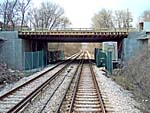 |
asbury05.jpg
(273k) |
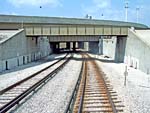 |
ROW@HowardYardLoop.jpg
(223k) |
 |
cta5000s01.jpg (98k) A pair of prototype 5000-series cars works the Yellow Line in the late afternoon of February 1, 2011, battling driving snow as the train approaches Kostner Avenue on its way back to Howard. The snow would eventually accumulate to approximately 21 inches, and although most of the "L" would stay running through and after the blizzard, Yellow Line service was annulled on February 2 due to blowing snow and substantial drifts that accumulated on the ground-level right-of-way. (Photo by Bob Bresse-Rodenkirk) |
 |
cta5009n.jpg (202k) Following a severe blizzard that left an average of about 21 inches of snowfall on the ground, Yellow Line service was annulled on February 2-3, resuming on February 4, 2011. With more snow and freezing temperatures in the following days, the snow stuck around for a while, not only on the ground but caked to the railcars as well, as evidenced by car 5009's front chains, sill, and anti-climber as it leads a Skokie-bound train crossing Niles Center Road on February 6, 2011. (Photo by Bob Bresse-Rodenkirk) |

|
cta2896snow.jpg (165k) |
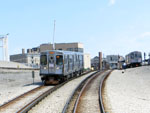 |
cta5176b.jpg (217k) Having departed Howard station and passed through the interlocking at the entrance to Howard Yard, car 5176 leads a Yellow Line train coming down the hill to pass under the yard's loop track, Chicago Avenue and the Metra Union Pacific tracks before entering the open cut right-of-0way on its way to Dempster on April 26, 2014. A Red Line train is visible at the top of the hill, having just turned around, coming off the loop track. The Yellow Line train is sporting a classic Skokie Swift sign for the line's 50th anniversary. (Photo by Graham Garfield) |
 |
cta5177.jpg (304k) After completing its trip north and discharging its passengers at Dempster-Skokie station, a Yellow Line train trailed by car 5177 is pulling through the switch at the entrance to the turnback track, where trains switch the the inbound track and train operators can change ends -- powering down the motorcab at one end, walk the length of the train, and power up the cab at the other end -- without blocking the mainline track or station platform, on April 25, 2014. The train is passing over the ground-level walkway that connects the station park & ride, kiss & ride and bus terminal with the station house on the west side of the tracks. The crossing is labeled as "Dempster", but the street is actually several hundred feet north, beyond the end of the turnback track. (Photo by Graham Garfield) |
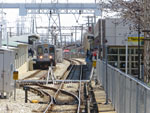 |
cta5238c.jpg (328k) Yellow Line run 591 discharges its passengers at Dempster-Skokie station before preparing to pull forward onto the turnback track, looking south from the turnback track on April 26, 2014. On the turnback stub, the train's operator will "change ends" and operate the train from the opposite end to begin its southbound return trip. The turnback switch it not interlocked, but it is powered and run automatically by a "speed frater". (Photo by Graham Garfield) |
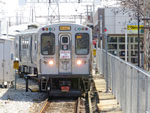 |
cta5238d.jpg (286k) The operator of run 591 is pulling her Yellow Line train through the speed frater switch and onto the turnback track so she can reverse direction and begin the return trip to Howard on April 26, 2014. The train sports classic Skokie Swift signs on its front and rear chains in honor of the line's 50th anniversary -- in the 1960s and 70s, cars normally assigned to the line had these signs permanent mounted to the cab-end of each car, but extras that could be hung on end-door chains were kept to use on other cars that needed to "sub in" for Swift service. With the "Swift bird" used since the line began still used on the 5000-series cars' LED destination signs, the bird icon is seen on car 5238 simultaneously in both digital and analog forms. (Photo by Graham Garfield) |
|
|